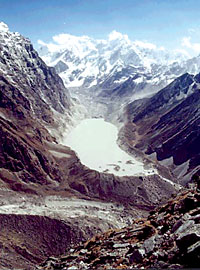 The mountains of Asia, including the Himalaya, are facing accelerating threats from a rapid rise in roads, settlements, overgrazing and deforestation that could worsen the impact of climate change and threaten water supply in China, southeast Asia and northern India.
The mountains of Asia, including the Himalaya, are facing accelerating threats from a rapid rise in roads, settlements, overgrazing and deforestation that could worsen the impact of climate change and threaten water supply in China, southeast Asia and northern India. The region's water supplies, fed by glaciers and the monsoons and vital for around half the world's population, may be harmed along with the area's abundant and rich wildlife. A new report points to a critical gap in water security to billions of people in Asia and the crucial role of sound environmental management for sustained development.
The report, The Fall of Water, was published by the IUCN and UNEP with support from the Kathmandu-based International Centre for Integrated Mountain Development (ICIMOD) and the Chinese Academy of Sciences. The study is based on a new way of assessing the direct and cumulative impacts of infrastructure development called Global Methodology for Mapping Human Impacts on the Biosphere (GLOBIO). It has been developed by UNEP's GRID Arendal centre in Norway, UNEP World Conservation Monitoring Centre in the UK and the Netherlands Environmental Assessment Agency.
Comparing satellite images from the 1960s to today reveal that deforestation and unsustainable land use practices make the region's rivers carry the largest sediment loads in the world causing increased flood-related disasters in China and India.
Researchers say Himalayan countries like China and Nepal are now acting to develop parks and protected areas aimed at conserving the Asian region's water supplies and wildlife but they warn that far more effort is needed to extend protection right across the region in both lowland and mountain areas.
The water from the Himalaya and the Tibetan Plateau flows down to half of the world's population, but less than three percent of the watersheds are protected. Many have become deforested and overgrazed. Impoverished people often have to settle in the most exposed flood-risk areas, and when the forest is gone further upstream, the floods will hit them severely. Rivers that originate in the Himalayan region like the Huang De, Indus, Amu Darya, Ganga and Salween, have on average of just 2.5 per cent of their basins protected.
The report argues that climate change is likely to aggravate problems with water supplies. Studies by ICIMOD and UNEP have shown that some 50 lakes have formed in Nepal, Bhutan and China as a result of melting glaciers. There is concern that these lakes held back by soil and stones, could burst their banks sending flash floods down densely populated valleys.
New calculations by the Chinese Academy of Sciences show seven percent of the country's glaciers are vanishing annually and that, by 2050, as many as 64 percent of China's glaciers will have disappeared. Close to half of the Asia's mountain region is affected by infrastructure development and that, by 2030, this could rise to over 70 percent.
The hotspots are along the Karakoram highway in Pakistan, the southern slopes of the Himalaya and in south-eastern Tibet, Yunnan and Sichuan provinces of south- western China. All countries in the region are likely to see a decline in the abundance of wildlife over the next three decades on current trends of infrastructure development.
There is particular concern over remaining fragile populations of species like the snow leopard, the Black necked crane, Przewalski's gazelle and the Whooper Swan.
"Most serious is the situation in parts of Pakistan, northern India, Bangladesh where human population pressures together with unchecked piecemeal development have great impacts on biodiversity and the ability of watersheds to handle monsoon floods," says Surendra Shrestha, director of UNEP's Regional Office for Asia and the Pacific in Bangkok.
The Fall of Water: Emerging threats to the water resources and biodiversityat the roof of the world to Asia's lowland from changes associated with large-scale settlement and piecemeal development.
http://globio.info/press/2005-09-05.cfm
www.unep.org


